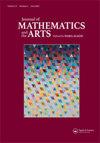Making mathematical physics accessible with affordable materials
IF 0.3
Q4 MATHEMATICS, INTERDISCIPLINARY APPLICATIONS
引用次数: 0
Abstract
I decided to studymeteorology after a frightening encounter with a severe thunderstorm in the spring of 2011. I declared a physics major the next fall, despite never having taken precalculus. Along the way I fell in love with math and physics in their own right. As a visual learner, much of my understanding came through deriving concepts by drawing, but my frustrations with the loss of information inherent to presenting 3D concepts through 2D means led me to first investigate the use of sculpture as a way of solidifying my understanding. After encountering Oliver Byrne’s 1849 illustrated version of Euclid’s Elements, I realized it was possible to create visual aids that simultaneously have enough pedagogical value for use in a classroom and enough artistic merit that they would not look out of place in the living room of someone with no mathematical inclinations. This led to my current workwhich focuses on the use of cheap and easily availablematerials to create beautiful but practical visualizations that serve as concrete, tangible illustrations of otherwise abstract, cerebral concepts in analysis and mathematical physics. Robert Sabuda’s elaborateWizard of Oz pop-up book was hugely inspirational as a poor student: the idea that such dynamic 3D illustrations could be created with a material as cheap, widely available, and humble as paper was powerful to me. While still in school, I began dabbling in paper engineering, excited I had found a sculptural media that I could easily afford. But even after I was no longer constrained by financial necessity, my fixation on cheapmaterials remained because, in imposing such restrictions onmyself, I was giving myself creative challenges that forced me to find novel solutions, some of which required the invention of entirely new sculptural techniques. Since graduating with a double major inmath and academic physics and a studio artminor inDecember 2016,mymaterial repertoire has grown to include plastic beads, embroidery floss, 3D printed PLA, clear plastic cocktail straws, motherboard washers, acrylic rod, Copic alcohol ink markers, their refill inks straight from the bottle, and Mylar plastic film. The combination of alcohol ink and Mylar has especially captured my imagination, and I have made it something of a mission to see howmany different topics in math and physics I can illustrate using the two. Among my favourite pieces borne out of this endeavour is this hanging mobile featuring six of the atomic orbitals of hydrogen (Figure 1), created using a sculptural technique of my own invention.用负担得起的材料使数学物理变得容易
2011年春天,我遭遇了一场可怕的大雷暴,之后我决定学习气象学。第二年秋天,尽管从未上过微积分预科,我还是选择了物理专业。一路走来,我爱上了数学和物理本身。作为一名视觉学习者,我的大部分理解都是通过绘画来获得概念的,但我对通过2D手段呈现3D概念所固有的信息丢失的挫折感使我首先研究了雕塑作为巩固我理解的一种方式。在看到奥利弗·伯恩(Oliver Byrne) 1849年的图解版《欧几里得几何原理》(Euclid’selements)后,我意识到有可能创造出一种视觉辅助工具,既能在课堂上使用,又有足够的教学价值,而且具有足够的艺术价值,在没有数学倾向的人的客厅里也不会显得不合适。这导致了我目前的工作,重点是使用廉价和容易获得的材料来创建美丽但实用的可视化,作为具体的,有形的插图,否则抽象的,分析和数学物理中的大脑概念。罗伯特·萨布达精心制作的《绿野仙踪》立体画册对我这个穷学生来说是巨大的鼓舞:这种动态的3D插图可以用像纸一样便宜、容易获得、简陋的材料来创作,这种想法对我来说是强大的。还在上学的时候,我就开始涉足纸工程,我很兴奋地发现了一种我能负担得起的雕塑媒介。但是,即使在我不再受经济需求的限制之后,我对廉价材料的执着仍然存在,因为在给自己施加这些限制的同时,我给自己提出了创造性的挑战,迫使我寻找新的解决方案,其中一些需要发明全新的雕塑技术。自2016年12月以数学和学术物理双学位和艺术工作室毕业以来,我的材料系列已经发展到包括塑料珠,刺绣牙线,3D打印PLA,透明塑料鸡尾酒吸管,主板清洁剂,丙烯酸棒,Copic酒精墨水标记,直接从瓶子中重新填充墨水,以及聚酯薄膜。酒精油墨和聚酯薄膜的结合尤其吸引了我的想象力,我把这当作一项任务,看看我能用这两种材料来说明多少数学和物理的不同主题。我最喜欢的作品之一是这个悬挂的移动装置,它有六个氢原子的原子轨道(图1),使用了我自己发明的雕塑技术。
本文章由计算机程序翻译,如有差异,请以英文原文为准。
求助全文
约1分钟内获得全文
求助全文
来源期刊

Journal of Mathematics and the Arts
MATHEMATICS, INTERDISCIPLINARY APPLICATIONS-
CiteScore
0.50
自引率
0.00%
发文量
19
 求助内容:
求助内容: 应助结果提醒方式:
应助结果提醒方式:


